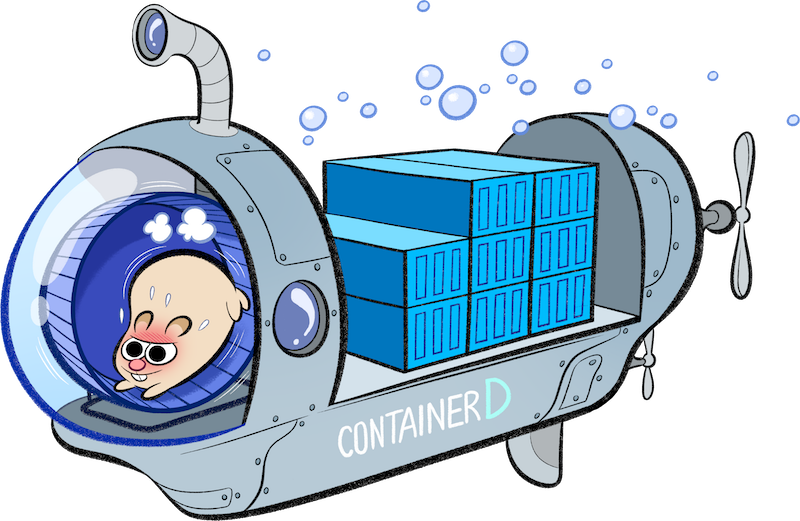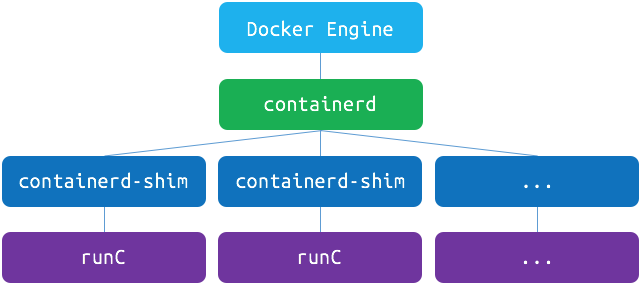
containerd是一个高性能的容器(container)伺服系统(查看源码),部分功能与Docker很像,相当于Docker Daemon模式和更新版的DockerD。
- containerd采用并行启动技术,可以每秒启动上百个容器实例。containerd提供命令行和REST服务接口,里面对容器真正的管理是通过containerd-shim进程来完成。
- 与Docker Engine的一锅烩模式不同的是,containerd并不管理容器的镜像,主要支持OCI(https://www.opencontainers.org/)开放容器标准的镜像,通过runc来启动。
- OCI镜像可以通过Docker镜像转换而来(参见:https://github.com/docker/containerd/blob/master/docs/bundle.md)。
containerd与大家熟知的Docker可谓相生相克,最新发展出的关系如下图所示。
- Docker从1.11开始,已经支持containerd和runc来运行容器。在DockerD服务启动时自动启动了containerd作为后台进程服务(可以通过ps aux | grep docker查看)。
- 更详细的中文介绍参考:http://dockone.io/article/1327 。

下面是containerd的官方介绍,原文:https://containerd.tools/
About containerd
Containerd is a daemon with an API and a command line client, to manage containers on one machine. It uses runC to run containers according to the OCI specification. Containerd has advanced features such as seccomp and user namespace support as well as checkpoint and restore for cloning and live migration of containers. The code can be found on Github. Containerd is currently available as an alpha release.
Built for Performance
Starting 1000 containers concurrently runs at 126-140 containers per second.
Easy to use
Containerd provides a daemon and a command line client to manage containers.
Battle Hardened
Containerd is built on runC, the same container technology powering millions of Docker Engine installations.
Compatible with Docker
Docker images can be run with containerd.
Getting Started
Daemon options
$ containerd -h
NAME:
containerd - High performance container daemon
USAGE:
containerd [global options] command [command options] [arguments...]
VERSION:
0.0.4
AUTHOR(S):
@crosbymichael <crosbymichael@gmail.com>
COMMANDS:
help, h Shows a list of commands or help for one command
GLOBAL OPTIONS:
--id "deathstar" unique containerd id to identify the instance
--debug enable debug output in the logs
--state-dir "/run/containerd" runtime state directory
-c, --concurrency "10" set the concurrency level for tasks
--metrics-interval "1m0s" interval for flushing metrics to the store
--listen, -l "/run/containerd/containerd.sock" Address on which GRPC API will listen
--oom-notify enable oom notifications for containers
--help, -h show help
--version, -v print the version
GRPC API
The API for containerd is with GRPC over a unix socket located at the default location of /run/containerd/containerd.sock.
At this time please refer to the proto definition for the API methods and types.
There is a Go implementation and types checked into this repository but alternate language implementations can be created using the grpc and protoc toolchain.
containerd CLI
There is a default cli named ctr based on the GRPC api. This cli will allow you to create and manage containers run with containerd.
NAME:
ctr - High performance container daemon controller
USAGE:
ctr [global options] command [command options] [arguments...]
VERSION:
0.0.4
AUTHOR(S):
@crosbymichael <crosbymichael@gmail.com>
COMMANDS:
checkpoints list all checkpoints
containers interact with running containers
events receive events from the containerd daemon
help, h Shows a list of commands or help for one command
GLOBAL OPTIONS:
--debug enable debug output in the logs
--address "/run/containerd/containerd.sock" address of GRPC API
--help, -h show help
--version, -v print the version
Listing containers
$ sudo ctr containers
ID PATH STATUS PID1
1 /containers/redis running 14063
19 /containers/redis running 14100
Starting a container
$ ctr containers start -h
NAME:
start - start a container
USAGE:
command start [command options] [arguments...]
OPTIONS:
--checkpoint, -c checkpoint to start the container from
--attach, -a connect to the stdio of the container
$ sudo ctr containers start redis /containers/redis
Kill a container’s process
$ ctr containers kill -h
NAME:
kill - send a signal to a container or it's processes
USAGE:
command kill [command options] [arguments...]
OPTIONS:
--pid, -p "0" pid of the process to signal within the container
--signal, -s "15" signal to send to the container
Exec another process into a container
$ ctr containers exec -h
NAME:
exec - exec another process in an existing container
USAGE:
command exec [command options] [arguments...]
OPTIONS:
--id container id to add the process to
--attach, -a connect to the stdio of the container
--cwd current working directory for the process
--tty, -t create a terminal for the process
--env, -e [--env option --env option] environment variables for the process
--uid, -u "0" user id of the user for the process
--gid, -g "0" group id of the user for the process
Stats for a container
$ ctr containers stats -h
NAME:
stats - get stats for running container
USAGE:
command stats [arguments...]
List checkpoints
$ sudo ctr checkpoints redis
NAME TCP UNIX SOCKETS SHELL
test false false false
test2 false false false
Create a new checkpoint
$ ctr checkpoints create -h
NAME:
create - create a new checkpoint for the container
USAGE:
command create [command options] [arguments...]
OPTIONS:
--tcp persist open tcp connections
--unix-sockets perist unix sockets
--exit exit the container after the checkpoint completes successfully
--shell checkpoint shell jobs
Get events
$ sudo ctr events
TYPE ID PID STATUS
exit redis 24761 0
Performance
Starting 1000 containers concurrently runs at 126-140 containers per second.
Overall start times:
[containerd] 2015/12/04 15:00:54 count: 1000
[containerd] 2015/12/04 14:59:54 min: 23ms
[containerd] 2015/12/04 14:59:54 max: 355ms
[containerd] 2015/12/04 14:59:54 mean: 78ms
[containerd] 2015/12/04 14:59:54 stddev: 34ms
[containerd] 2015/12/04 14:59:54 median: 73ms
[containerd] 2015/12/04 14:59:54 75%: 91ms
[containerd] 2015/12/04 14:59:54 95%: 123ms
[containerd] 2015/12/04 14:59:54 99%: 287ms
[containerd] 2015/12/04 14:59:54 99.9%: 355ms
来源:oschina
链接:https://my.oschina.net/u/2306127/blog/804251